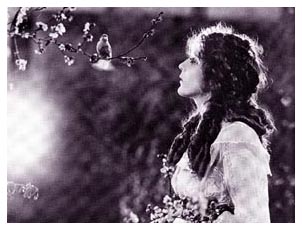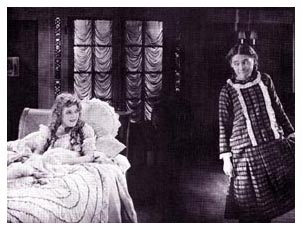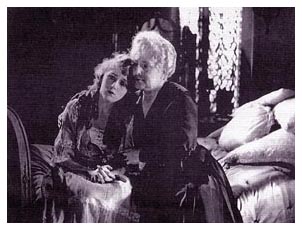

Pickford Film Corp. - Famous Players-Lasky
Cast: Mary Pickford (Stella Maris/Unity Blake), Conway Tearle
(John Risca), Marcia Manon (Louise Risca), Ida Waterman (Lady
Blount), Herbert Standing (Sir Oliver Blount), Josephine Crowell
(Gladys Linden), Mrs. Coonleu (The nurse), Teddy (himself)
Consider the opening title of "Stella Maris" (1918):
"Stella Maris, paralyzed from childhood, has been tenderly shielded from all the sordidness and misery of life. So she dwells serenely within a dream-world, created by those who love her, unaware of sorrow, poverty and death."
Now, take away the paralysis; what strikes
us here is that the remaining title might well have described
the 1910's filmgoing audiences' view of the archetypal "Little
Mary" character of Mary Pickford, already at that point one
of the most famous film stars - perhaps the most famous
-- in the world. It was a character not so much created by, but
nurtured by the audiences that loved her, and Pickford
easily could have left the character serene and complacent in
a dream world, free from any constraints to face the harsh realities
of life. 
But Pickford was a courageous and remarkable manager of her career. As one reads Scott Eyman's and Eileen Whitfield's biographies, one marvels at the backbone and brilliance of the woman who early on became the breadwinner of her family; who, through her business savvy, built an empire and (as the title of Whitfield's book reminds us) made Hollywood; who was never content to rest on the laurels of stardom, but wanted to be an actress. So she must have been especially intrigued when she discovered, through her screenwriter friend Frances Marion's urging, William J. Locke's novel "Stella Maris" and sensed the part of a lifetime. Kevin Brownlow, in his Mary Pickford Rediscovered, summarizes the plot of the screenplay that Marion then adapted:
"Confined to bed by a crippling illness, Stella Maris (Mary Pickford) is sheltered to the point that all bad news is kept from her; she looks out on peaceful scenery and is visited by pet animals, charming children, and John Risca (Conway Tearle). Urbane and handsome, Risca is a journalist with a secret - his wife, Louise (Marcia Manon), is an alcoholic and drug addict. One day, Louise visits an orphanage, wanting not so much a foster child as a free servant. She treats the homely girl, Unity Blake (also played by Mary Pickford), so abominably that eventually the neighbors burst in, find the girl has been beaten unconscious, and call the police. When Louise begins her term of imprisonment for the assault, Unity is set free. She is adopted by John after he sees her in the hospital and is appalled by the savagery of the beating inflicted by his wife. John continues to pay visits to Stella Maris and is overjoyed when she has an operation that enables her to walk. Unity comes to stay at Stella's house, and the two meet momentarily. Stella falls in love with John, and hearing so much about his "castle," as he terms his house, determines to visit it. Here she receives the double shock of discovering not only that John is married, but married to a woman just out of jail. Unity has also fallen in love with John, from afar, for he is the first person to have treated her kindly. When she realizes that his wife is making John's life a living hell, Unity pays her a visit . . ."
Immediately following the opening intertitle mentioned above, we are treated to the first of many close-ups that surely left audiences sighing for their Little Mary: there, setting the screen aglow, are the porcelain skin, the shining eyes and long lashes, the dazzling smile, the famous cascading curls. There, to paraphrase a later intertitle, we have proof enough that God's in His Heaven and all's well with the world. But swift on the heels is another introduction:
 "Another little
prisoner of fate is Unity Blake, "The Ugly Duckling"
of a London orphanage."
"Another little
prisoner of fate is Unity Blake, "The Ugly Duckling"
of a London orphanage."
Understand that when I recently showed this film to one of my college classes, about half of the students didn't realize that the following shot was also of Mary Pickford, and several never caught on, during the course of the film, that Pickford was Unity. Here we have the curls slicked down by Vaseline, the teeth darkened, the shoulders hunched over, and eyes fearfully anticipating a beating. The publicity still on the left doesn't really do justice to the transformation - Unity looks too hopeful and bright - but you do get an idea of the gulf between the two characters. They share several shots in the film, and, thanks to Pickford's meticulously delineated performances and Harry Stradling's photography, the suspension of disbelief remains. Amazon.com reviewer Laura Mirsky hits the nail on the head when she espouses that
"Make-up, hair, and costumes help achieve this remarkable transformation. Stella Maris is radiantly pretty, with bright eyes and lips and flowing curls, decked out in ruffled white frocks. Unity is painfully plain: sallow-skinned and dull-haired, in an orphan's homespun, shapeless shift. But it is Pickford's extraordinary facility with body language -- the true sign of a great silent-film actress -- that makes each character so distinct and credible. Privileged Stella Maris's movements are always graceful and dainty, whereas Unity stoops and flinches, the victim of a lifetime of want and abuse."
In either guise, Pickford is onscreen about
90 percent of the film's 84 minutes, and it's her show all the
way. The other players (Tearle in particular) are understated
to the point of blandness, except for Manon, whose evil Louise
is rather over the top - more Simon Legree than anything else
- but no  matter: the dichotomy between Pickford's
two characters is so rigorously sustained, and finally so compelling,
that we really don't focus on anything else. As Stella Maris moves
beyond naivete and grows in her comprehension of the world, she
also grows in depth when her initial reactions take her through
disbelief, disillusionment, and a sense of betrayal. As she comes
to understand and embody the essential quality of forgiveness.
she becomes a more warmly beautiful character. But we almost -
almost, now - push her aside: it's the inner life of Unity, "pitied
but unloved," that grabs our hearts, leaving us wanting more.
matter: the dichotomy between Pickford's
two characters is so rigorously sustained, and finally so compelling,
that we really don't focus on anything else. As Stella Maris moves
beyond naivete and grows in her comprehension of the world, she
also grows in depth when her initial reactions take her through
disbelief, disillusionment, and a sense of betrayal. As she comes
to understand and embody the essential quality of forgiveness.
she becomes a more warmly beautiful character. But we almost -
almost, now - push her aside: it's the inner life of Unity, "pitied
but unloved," that grabs our hearts, leaving us wanting more.
One shot in particular of Unity may be the
finest moment of Pickford's career. It's worth noting that several
of the most affecting sequences in her other films involve children:
when she holds a dying child in both "Sparrows" (1927)
and "Secrets" (1933), she shows in close-up her characters'
reserves of both compassion and despair, as well as the vulnerability
that hides behind fortitude. Here, in "Stella Maris,"
we have another child - the Unity behind the wryly shrugging,
toughened orphan - on display. Unity gazes admiringly at a beautiful
photograph of Stella Maris that John keeps on his desk and then
walks to a mirror as she continues to gaze at the photograph.
In a remarkable shot lasting thirty seconds, Unity lifts her eyes
from the photograph to her plain reflection, gazing with the growing
realization that she never will have the  man
she loves, and then bows her head in despair. It's a sequence
as heart stopping as the moment when Charlie Chaplin sees the
formerly blind girl with sight restored near the end of "City
Lights" (1931), and is beautifully complemented (as is the
rest of the film) by Philip Carli's unobtrusive orchestral score.
I've often alluded in these reviews to those moments when the
power of silent film is at its zenith as the fusion of music,
performance, and image leaves us - to use George Pratt's term
- spellbound in darkness. Here is the Pickford whom audiences
of today know almost nothing about, an artist whose talent was
far more versatile than the filmgoing public finally allowed.
man
she loves, and then bows her head in despair. It's a sequence
as heart stopping as the moment when Charlie Chaplin sees the
formerly blind girl with sight restored near the end of "City
Lights" (1931), and is beautifully complemented (as is the
rest of the film) by Philip Carli's unobtrusive orchestral score.
I've often alluded in these reviews to those moments when the
power of silent film is at its zenith as the fusion of music,
performance, and image leaves us - to use George Pratt's term
- spellbound in darkness. Here is the Pickford whom audiences
of today know almost nothing about, an artist whose talent was
far more versatile than the filmgoing public finally allowed.
"Stella Maris" is a remarkable work, both for Pickford's performance and for the film's frankness in confronting the issues of child abuse and alcoholism. The only reservation I have about it is the vaguely (but insistently) disturbing context of its swift conclusion: Unity commits suicide and is called a "great soul" by Stella and John, who unite in bliss as the film (literally) rides off to a happy fade-out. Are we to take for granted, then, that the maimed and downtrodden sacrifice themselves, thus paving way for the beautiful to enjoy their place in the sun? But I should add in fairness that Marion may have felt compelled to stay with the similar conclusion of Locke's novel, which was extremely popular in its day.
And, in any case, the beautiful people are not the ones whom we remember in "Stella Maris." It is the valiant, hesitant, tender, scrappy figure of Unity Blake, played with truth and immediacy by the most famous and beautiful film star of her day, that stays with us, haunting us still. Mary Pickford, the actress occasionally hidden by the towering figure of "America's Sweetheart," could have no finer testimonial to her talent.
Copyright 2007 by Dean Thompson. All
rights reserved.